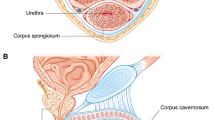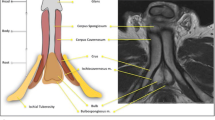Abstract
Purpose
To evaluate the performance of non-erectile MRI in staging and preoperative evaluation of penile carcinomas, compared to postoperative histopathology.
Methods
In this retrospective study, MRI scans of patients who had undergone surgery for penile carcinoma (n = 54) between January 2012 and April 2018 were read by two radiologists; and disagreement was solved in the presence of a third experienced radiologist. Data necessary for preoperative evaluation and staging were collected and compared with final postoperative histology and the type of surgery performed. All MRI had been performed without intracavernosal injection of prostaglandin E1 and with IV Gadolinium, as per local protocol.
Results
54 patients were included in the study (mean age 57.52 ± 12.78). The number of patients with T1, T2, and T3 staging in histopathology were 32, 14, and 8. Moderate interobserver agreement was found for staging, disease-free penile length, and all subsites except urethra, which had weak agreement. Strong agreement of consensus MRI with final histopathological staging was found (49/54, weighted κ = 0.85), with high sensitivity and specificity. Sensitivity and specificity for involvement of corpus spongiosum, corpora cavernosa, and urethra were 95.5% and 93.8%, 87.5% and 97.8%, and 90.9% and 86.1%, respectively. Sensitivity (89.6%) and specificity (100%) of MRI for predicting adequate disease-free penile length were high.
Conclusion
There were acceptable interobserver agreement and good diagnostic performance of MRI for staging and preoperative assessment without intracavernosal injection, especially for higher stages and higher degrees of invasion which require more extensive surgery.






Similar content being viewed by others
Data availability
All data and material used are available with the parent Institute.
Code availability
Software used are either freely available online or available with the hospital.
Abbreviations
- PGE1 :
-
Prostaglandin E1
- IV :
-
Intravenous
References
Hanchanale V, Yeo L, Subedi N, Smith J, Wah T, Harnden P, Bhattarai S, Chilka S, Eardley I (2016) The accuracy of magnetic resonance imaging (MRI) in predicting the invasion of the tunica albuginea and the urethra during the primary staging of penile cancer. BJU Int 117:439–443
Amin MB, Edge SB (2017) AJCC cancer staging manual. springer
Hakenberg OW, Compérat E, Minhas S, Necchi A, Protzel C, Watkin N (2018) EAU Guidelines on Penile Cancer. EAU Guidelines
Lont AP, Besnard APE, Gallee MPW, van Tinteren H, Horenblas S (2003) A comparison of physical examination and imaging in determining the extent of primary penile carcinoma. BJU Int 91:493–495
Ficarra V, Righetti R, D’Amico A, Pilloni S, Balzarro M, Schiavone D, Malossini G, Mobilio G (2000) General state of health and psychological well-being in patients after surgery for urological malignant neoplasms. Urol Int 65:130–134
Scardino E, Villa G, Bonomo G, Matei DV, Verweij F, Rocco B, Varela R, de Cobelli O (2004) Magnetic resonance imaging combined with artificial erection for local staging of penile cancer. Urology 63:1158–1162
Kirkham A (2012) MRI of the penis. Br J Radiol 85 Spec No 1:S86–93
Linet OI, Neff LL (1994) Intracavernous prostaglandin E1 in erectile dysfunction. Clin Investig 72:139–149
Kunelius P, Lukkarinen O (1999) Intracavernous self-injection of prostaglandin E1 in the treatment of erectile dysfunction. Int J Impot Res 11:21–24
Muruve N, Hosking DH (1996) Intracorporeal phenylephrine in the treatment of priapism. J Urol 155:141–143
Krishna S, Shanbhogue K, Schieda N, Morbeck F, Hadas B, Kulkarni G, McInnes MD, Baroni RH (2020) Role of MRI in Staging of Penile Cancer. J Magn Reson Imaging https://doi.org/10.1002/jmri.27060
Lucchesi FR, Reis RB, Faria EF, Machado RD, Rossini RR, Borregales LD, Silva GEB, Muglia VF (2017) Incremental value of MRI for preoperative penile cancer staging. J Magn Reson Imaging 45:118–124
Edge SB, Compton CC (2010) The American Joint Committee on Cancer: the 7th edition of the AJCC cancer staging manual and the future of TNM. Ann Surg Oncol 17:1471–1474
Sun M, Djajadiningrat RS, Alnajjar HM, Trinh Q-D, Graafland NM, Watkin N, Karakiewicz PI, Horenblas S (2015) Development and external validation of a prognostic tool for prediction of cancer-specific mortality after complete loco-regional pathological staging for squamous cell carcinoma of the penis. BJU Int 116:734–743
Leijte JAP, Gallee M, Antonini N, Horenblas S (2008) Evaluation of current TNM classification of penile carcinoma. J Urol 180:933–8; discussion 938
Pretorius ES, Siegelman ES, Ramchandani P, Banner MP (2001) MR imaging of the penis. Radiographics 21 Spec No:S283–98; discussion S298–9
Philippou P, Shabbir M, Malone P, Nigam R, Muneer A, Ralph DJ, Minhas S (2012) Conservative surgery for squamous cell carcinoma of the penis: resection margins and long-term oncological control. J Urol 188:803–808
Hakenberg OW, Compérat EM, Minhas S, Necchi A, Protzel C, Watkin N (2015) EAU guidelines on penile cancer: 2014 update. Eur Urol 67:142–150
Guimarães GC, Rocha RM, Zequi SC, Cunha IW, Soares FA (2011) Penile cancer: epidemiology and treatment. Curr Oncol Rep 13:231–239
Solsona E, Bahl A, Brandes SB, Dickerson D, Puras-Baez A, van Poppel H, Watkin NA (2010) New developments in the treatment of localized penile cancer. Urology 76:S36–42
Engelsgjerd JS, LaGrange CA (2019) Cancer, Penile. StatPearls
McHugh ML (2012) Interrater reliability: the kappa statistic. Biochem Med 22:276–282
Kayes O, Minhas S, Allen C, Hare C, Freeman A, Ralph D (2007) The role of magnetic resonance imaging in the local staging of penile cancer. Eur Urol 51:1313–8; discussion 1318–9
Bozzini G, Provenzano M, Romero Otero J, et al (2016) Role of Penile Doppler US in the Preoperative Assessment of Penile Squamous Cell Carcinoma Patients: Results From a Large Prospective Multicenter European Study. Urology 90:131–135
Horenblas S, Kröger R, Gallee MP, Newling DW, van Tinteren H (1994) Ultrasound in squamous cell carcinoma of the penis; a useful addition to clinical staging? A comparison of ultrasound with histopathology. Urology 43:702–707
Velazquez EF, Soskin A, Bock A, Codas R, Cai G, Barreto JE, Cubilla AL (2005) Epithelial abnormalities and precancerous lesions of anterior urethra in patients with penile carcinoma: a report of 89 cases. Mod Pathol 18:917–923
Monteiro LL, Skowronski R, Brimo F, Carvalho P da C Neto, Vasconcelos RAL, Pacheco CRCV, Calado AA, Kassouf W (2021) Erectile function after partial penectomy for penile cancer. Int Braz J Urol 47:515–522
Yu C, Hequn C, Longfei L, Minfeng C, Zhi C, Feng Z, Jinbo C, Lin Q, Xiongbing Z (2016) Sexual Function after Partial Penectomy: A Prospectively Study From China. Sci Rep 6:21862
Funding
No funds, grants, or other support was received.
Author information
Authors and Affiliations
Contributions
All authors contributed to the study conception and design. Material preparation, data collection, and analysis were performed by P. G, S. M, and A. C. The first draft of the manuscript was written by P. G and all authors commented on previous versions of the manuscript. All authors have read and approved the final manuscript.
Corresponding author
Ethics declarations
Conflicts of interest
The authors have no relevant financial or non-financial interests to disclose.
Ethical approval
This is an observational study. The protocol was submitted to the Institutional Review Board and the Board decided to issue protocol waiver (IRB review exemption) for the study.
Consent to participate
Taken. No patient identifiable data have been used in the submission. Protocol waiver was issued by the IRB.
Consent for publication
Taken. No patient identifiable data have been used in the submission. Protocol waiver was issued by the IRB.
Additional information
Publisher's Note
Springer Nature remains neutral with regard to jurisdictional claims in published maps and institutional affiliations.
Rights and permissions
About this article
Cite this article
Ghosh, P., Chandra, A., Mukhopadhyay, S. et al. Accuracy of MRI without intracavernosal prostaglandin E1 injection in staging, preoperative evaluation, and operative planning of penile cancer. Abdom Radiol 46, 4984–4994 (2021). https://doi.org/10.1007/s00261-021-03194-6
Received:
Revised:
Accepted:
Published:
Issue Date:
DOI: https://doi.org/10.1007/s00261-021-03194-6




